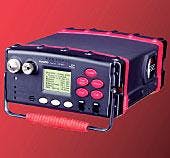The new PetroPR high-speed portable gas chromatograph is designed for accurate, rapid screening of common volatile organic compounds (VOCs) on site.
It weighs less than 15 lb (6.8 kg) and measures 13 in. (33 cm) long by 10.5 in. (27 cm) wide by 5 in. (13 cm) high. It can analyze benzene, toluene, ethylbenzene, and m-xylene (BTEX) compounds in less than 2 min down to parts per billion (ppb) levels.
A linear photoionization detector reports sample concentrations from low ppb up to hundreds of parts per million. The PetroPRO is designed for high-speed analysis of BTEX but can be modified for analysis of a range of VOCs. It incorporates proprietary valve technology to increase the resolution of GC peaks and speed of analysis.
The unit is suited for uses that include OSHA compliance, fenceline monitoring, petroleum tank preentry, and emergency response. It's certified as intrinsically safe for use in hazardous locations in North America and Europe.
A built-in graphic display lists the names of detected compounds as well as the concentration in the sample, eliminating the need to interpret results in the field. A new dedicated calibration CAL key reminds the user of the importance of regular calibration for maximum instrument accuracy and quick access to starting a calibration. The unit also features a dedicated start key for one-button operation of sample introduction.
An intuitive user interface allows quick and easy changes in the field, if needed. It is self-contained with a rechargeable battery pack, a built-in carrier gas cylinder, and an internal data logger that stores a full day of results. The internal data logger can be downloaded later to a PC for a permanent data archive of the day's results.
Source: Photovac Inc., 176 Second Ave., Waltham, MA 02451-1166.
New approach to picking seismic velocities
HDPIC is a new approach to picking seismic velocities that reconciles geologists and geophysicists by delivering geologically meaningful seismic attributes.
This is a new feature of A+ processing, which is a fully anisotropic seismic data processing service that exploits the earth's anisotropy to deliver a sharper, more focused image of the reservoir.
The company says its technology offers a way of getting geologists and geophysicists to agree on seismic velocities by delivering attributes that geologists can interpret while flattening the gathers.
Velocities are important for geologists and geophysicists but do not necessarily mean the same thing to each discipline. Anisotropy, which the firm says must be handled properly for velocities to become geologically meaningful, has remained unresolved by prestack migration schemes, it adds.
With HDPIC technology, the effects of anisotropy are effectively separated from velocity estimation so that the resulting fields make more geological sense, the firm points out.
Source: Cie. General de Geophysique, 1, rue Léon Migaux, 91341 Massy Cedex, France.
Photometer handles color monitoring in refineries
The new PUV3402 process photometer provides color monitoring in refineries.
It continuously monitors hydrocarbon liquids, and measurements can be made in Saybolt color units or ASTM color units.
The unit meets these refinery color measurements:
1. D156 ASTM method for gasoline, jet fuel, naphtha, and kerosine or –15 to +15 Saybolt color units.
2. D1500 ASTM method for lube oils, diesel fuel, or the equivalent 0-8 ASTM units.
The photometer uses narrow bandpass optical filters to measure light intensity at reference and measures wavelengths in the visible region of the spectrum.
The company says its optical bench features:
Reliable color analyses in refinery uses.
- A simple mechanical design that promotes easy service and maintenance.
- Automatic compensation for obstruction of cell windows.
- Automatic compensation for source and detector aging.
Source: ABB Ltd., Affolternstrasse 54, Box 8131, CH-8050 Zurich, Switzerland.
Free brochure discusses new pump line
A new 8 page, full color brochure details the launch of the enhanced Moyno 2000 pump line.
The lineup features the proprietary Moyno Ultra-Technologies, which are designed to optimize the durability, performance, and longevity of these pumps in handling viscous, abrasive materials—in excess of 80% solids.
The brochure covers the Moyno 2000 G1, G2, G3, and G4 models as well as the 2000 HS System.
Differentiation aspects of the pump line are identified along with corresponding performance features.
Details on application considerations, materials compatibility, and solids handling capabilities as well as product specifications, drawings, and specific features provided by the Moyno 2000 pump models are included.
The brochure describes the variety of accessories and options available to customize the 2000 pump line to meet specific application needs.
Source: Moyno Inc., Box 960, Springfield, OH 45501.

